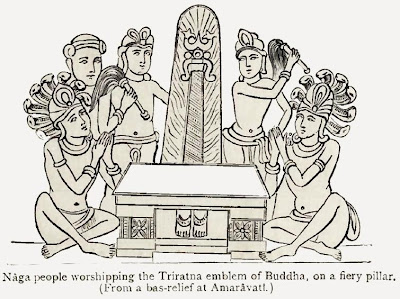Mirror: https://www.academia.edu/8788262/Tri-ratna_and_hieroglyphs_on_ancient_cast_coins_Meluhha_cipher_metalwork_continuum
See: http://bharatkalyan97.blogspot.com/2014/10/meluhha-hieroglyphs-evidence-of.html
The tradition of writing using hieroglyphs read rebus, consistent with the Meluhha cipher (mlecchita vikalpa) of Sarasvati-Sindhu (Hindu) civilization continued into the historical periods. In addition to the deployment of Meluhha hieroglyphs on early punch-marked and cast coins, evidenced also exists in architectural art forms.
In Jaina tradition, the three jewels are:
See: http://bharatkalyan97.blogspot.com/2014/10/meluhha-hieroglyphs-evidence-of.html
Meluhha hieroglyphs: evidence of continuum in ancient dharma-dhamma traditions
The tradition of writing using hieroglyphs read rebus, consistent with the Meluhha cipher (mlecchita vikalpa) of Sarasvati-Sindhu (Hindu) civilization continued into the historical periods. In addition to the deployment of Meluhha hieroglyphs on early punch-marked and cast coins, evidenced also exists in architectural art forms.
In Jaina tradition, the three jewels are:
- samyag-darśana (correct perception or insight)
- samyag-jñāna (correct knowledge)
- samyag-cāritra (correct conduct).
See:http://bharatkalyan97.blogspot.com/2014/10/meluhha-hieroglyphs-evidence-of.html
Bas-relief, Amaravati combines a fiery skambha (linga) with tri-ratna shows two Naga worshipping the hieroglyph composition. See:
Skambha Sukta in Atharva Veda and Lingas of Sarasvati-Sindhu civilization
http://bharatkalyan97.blogspot.com/2014/1
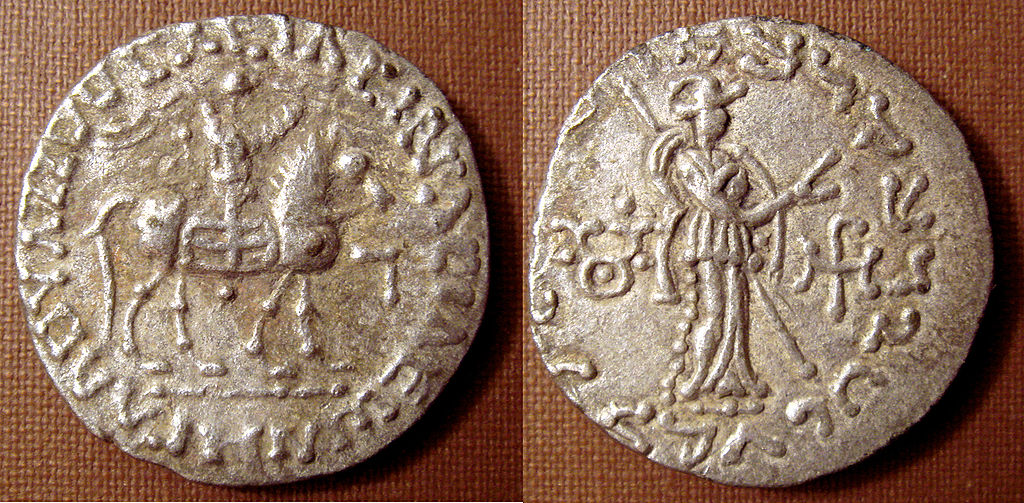 Tri-ratna on a coin of Indo-Scythian king Azes II (35-12 BCE).
Tri-ratna on a coin of Indo-Scythian king Azes II (35-12 BCE). Square seal (silver) from Karur, with symbols like the Srivatsa and legend in Tamil Brahmi: "Kuravan". Ist century B.C.E.
Square seal (silver) from Karur, with symbols like the Srivatsa and legend in Tamil Brahmi: "Kuravan". Ist century B.C.E. Tri-ratna, Amaravati.
Tri-ratna, Amaravati.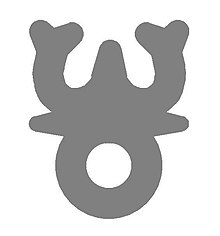 Triratna, 'three jewels' on Sanchi stupa. Pali: tiratana,tisarana Sanskrit: त्रिरत्न (triratna), रत्नत्रय (ratna-traya) Khmer: ព្រះរតនត្រ័យ (Preah Ratanak-trey) Marathi: त्रिशरण (trisharan) Bengali: ত্রিশরণtrishôrônô Sinhalese: තෙරුවන් (theruwan) or තුරුණුවන් (thurunawan) Also called nandipada, or "bull's hoof"
Triratna, 'three jewels' on Sanchi stupa. Pali: tiratana,tisarana Sanskrit: त्रिरत्न (triratna), रत्नत्रय (ratna-traya) Khmer: ព្រះរតនត្រ័យ (Preah Ratanak-trey) Marathi: त्रिशरण (trisharan) Bengali: ত্রিশরণtrishôrônô Sinhalese: තෙරුවන් (theruwan) or තුරුණුවන් (thurunawan) Also called nandipada, or "bull's hoof"The three jewels are: 1. The enlightened one; 2. The teaching; 3. The community.
(Chinese: 三寶; pinyin: sānbǎo; Wade–Giles: san-pao; literally: "three jewels/treasures").
- Buddham saranam gacchāmi
- I go for refuge in the Buddha.
- Buddha Sanskrit, Pali: The Enlightened or Awakened One;Chinese: 佛陀,Fótuó, Japanese:仏, Butsu, Standard Tibetan: sangs-rgyas,
- Dhammam saranam gacchāmi
- I go for refuge in the Dharma.
- Sangham saranam gacchāmi

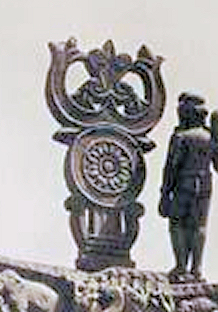 Srivatsa within a triratana, over a Chakra wheel, on the Northern Torana gate at Sanchi stupa.
Srivatsa within a triratana, over a Chakra wheel, on the Northern Torana gate at Sanchi stupa. Buddha footprint(bottom symbol in Tri-ratna, the top symbol is dharmachakra). 1st century CE, Gandhara.
Buddha footprint(bottom symbol in Tri-ratna, the top symbol is dharmachakra). 1st century CE, Gandhara.Hieroglyph: kaṇḍ'fire-altar' (Santali) Rebus: khānḍa ‘tools, pots and pans, metal-ware’.
Hieroglyph: ayo 'fish' Rebus: Ayo & Aya (nt.) [Sk. ayaḥ nt. iron & ore. Rebus: ayira 'noble person'
Hieroglyph: dāman ʻ rope ʼ, 'garland' Rebus: dāma 'Dharma' (Pali) . Thus, together, the tied pair of fishes denote: ayira dāma (Pali) ariya dhamma, dharma (Pali.Sanskrit)
Hieroglyph: embossed knob, karaḍā Rebus: karaḍā means 'hard alloy of metals such as gold, silver etc.' kharaḍa means a brief metalwork memorandum.
![]() Tri-ratna symbol on top of a stupa, Kuninda coin, 2nd c. BCE
Tri-ratna symbol on top of a stupa, Kuninda coin, 2nd c. BCE
Hieroglyphs on Kuninda coin: svastika, tree, mountain-range, portable furnace, markhor, woman, flowing water
Meluhha rebus readings:
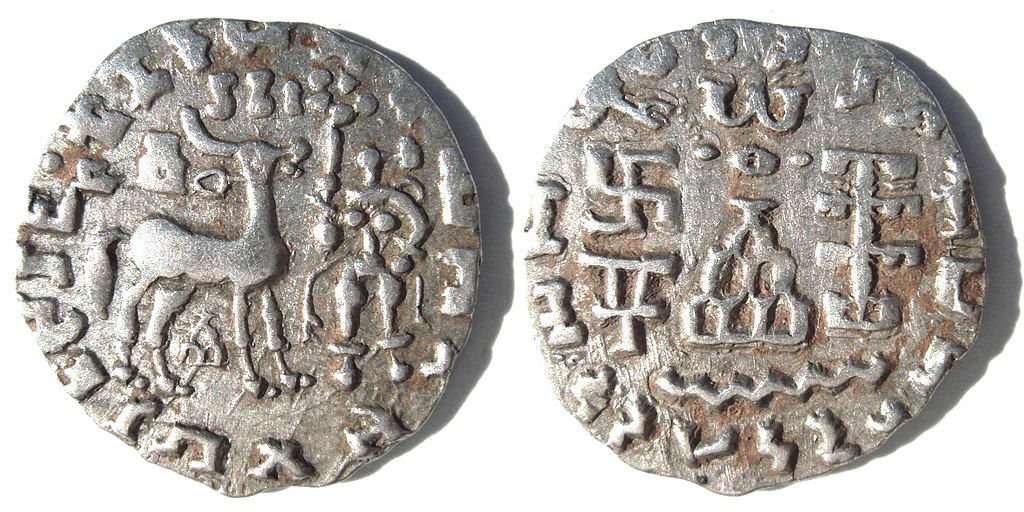 Tri-ratna symbol on top of a stupa, Kuninda coin, 2nd c. BCE
Tri-ratna symbol on top of a stupa, Kuninda coin, 2nd c. BCEHieroglyphs on Kuninda coin: svastika, tree, mountain-range, portable furnace, markhor, woman, flowing water
Meluhha rebus readings:
sattva 'svastika glyhph' Rebus: jasta 'zinc'
kuṭi ‘tree’ Rebus: kuṭhi ‘smelter’; kuṭhāru 'tree' Rebus: kuṭhāru 'armourer'
G. sãghāṛɔ m. ʻlathe’ 'portable furnaceRebus: संघाट joinery; M. sãgaḍ ‘double-canoe’ Rebus: sangataras ‘stone-cutter, mason’
Dm. mraṅ m. ‘markhor’ Wkh. merg f. ‘ibex’ (CDIAL 9885) Tor. miṇḍ ‘ram’, miṇḍā́l ‘markhor’ (CDIAL 10310) Rebus: meḍ (Ho.); mẽṛhet ‘iron’ (Munda.Ho.)
kola 'woman' Rebus: kol 'working in iron'; kolhe 'smelter'
kāṇḍa 'water' Rebus: kāṇḍa ‘tools, pots and pans and metal-ware’ Thus, cast bronze metalware.
Hieroglyphs: mountain-range, leaflesss tree: ḍã̄g mountain-ridge (H.)(CDIAL 5476). Rebus: dhangar ‘blacksmith’ (Maithili) ढांक [ ḍhāṅka ] n ढांकळ f C An old and decaying tree: also the stump or naked stalks and stem remaining (of a little plant).(Marathi) WPah.kṭg. ḍāṅg f. (obl. -- a) ʻ stick ʼ, ḍaṅgṛɔ m. ʻ stalk (of a plant) ʼ Rebus: ḍhangar blacksmith’ kolom ‘three’ Rebus: kolami ‘smithy, forge’ Vikalpa: khōṇḍa A tree of which the head and branches are broken off, a stock or stump: also the lower portion of the trunk—that below the branches. (Marathi) Rebus 1: kõdā 'to turn in a lathe' (Bengali) Rebus 2: koḍ 'workshop' (Gujarati)
S. Kalyanaraman
Sarasvati Research Center
October 15, 2014
